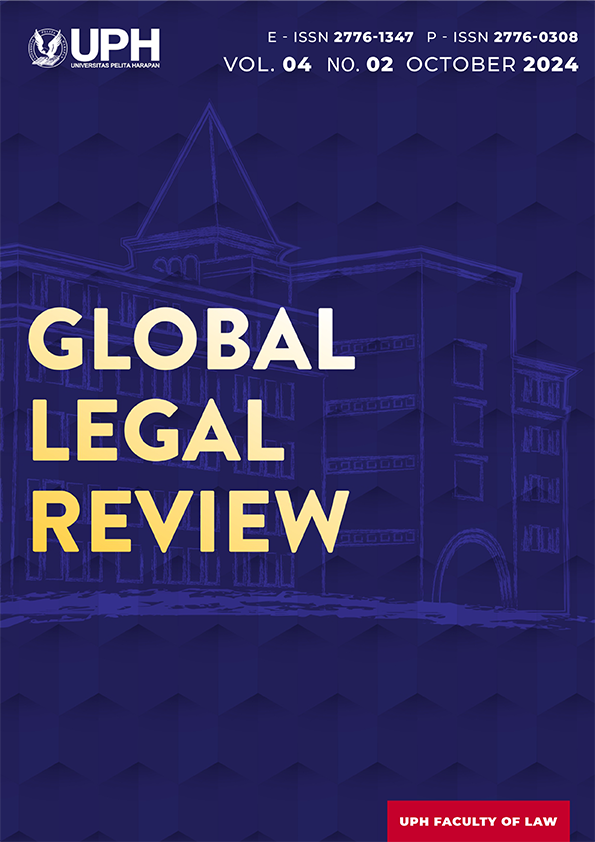Legal Protection for Creditors Against the Assets of Bankrupt Debtors Confiscated as Evidence
DOI:
https://doi.org/10.19166/glr.v4i2.8485Keywords:
General Confiscation, Confiscation, Creditor's ProtectionAbstract
The uncertainty of the status of affiliated bankruptcy debtors as evidence of criminal offenses is a classic problem that until now has not found an alternative legal solution. When a bankruptcy debtor is proven to have committed a criminal offense, resulting in the debtor's assets becoming evidence seized by the criminal, the curator will experience difficulties in the process of liquidating the debtor's assets. On the one hand, the prosecutor's office has the authority to confiscate the assets of the debtor (defendant), as well as the curator who has the authority to liquidate. The emergence of these two types of seizure is certainly intended to provide legal certainty and legal protection for the community. However, in its implementation, when the two types of seizure clash, the aspects of certainty and justice for the community will not be achieved. Therefore, it is necessary to establish regulations that can bridge or unravel the problem of attraction of seizure objects between the curator and the prosecutor's office. The research method used in this research is juridical-normative by using several research approaches, namely statute approach and conceptual approach. The use of statute approach in the research is intended to provide an overview of the construction of bankruptcy and criminal law so as to hamper the process of liquidation of bankruptcy assets. While the use of conceptual approach is intended as a basis for thinking to reconstruct the legal construction so as to create harmonious and synchronous bankruptcy and criminal regulations and can provide certainty and justice for the legal protection of creditors.
References
Andrian. “Juridical Review of the Application of Criminal Seizure and its Link with Bankruptcy Seizure.” Thesis, Universitas Katolik Indonesia Atma Jaya, 2022.
Andrian. “Sengketa Kewenangan dalam Proses Likuidasi Boedel Pailit antara Kurator dengan Kejaksaan Republik Indonesia.” Justisi 9, no. 3 (2023): 389-401. https://doi.org/10.33506/jurnaljustisi.v9i3.2509.
Fauzan, H. M., and Baharuddin Siagian. Kamus Hukum dan Yurisprudensi. Jakarta: Kencana, 2017.
Ginting, Elyta Ras. Hukum Kepailitan: Teori Kepailitan. Jakarta: Sinar Grafika, 2018.
Hamzah, Andi. Hukum Acara Pidana Indonesia. Jakarta: Sinar Grafika, 2017.
Harahap, Yahya. Hukum Acara Perdata. Jakarta: Sinar Grafika, 2017.
Harahap, Yahya. Ruang Lingkup Permasalahan Eksekusi Bidang Perdata. Jakarta: Sinar Grafika, 2019.
HRS. “Prokontra Sita Pidana vs Sita Umum Pailit.” Hukum Online, May 3, 2013. https://www.hukumonline.com/berita/a/prokontra-sita-pidana-vs-sita-umum-pailit-lt51836ecd9bbf8.
Tim Hukumonline. “Teori-Teori Perlindungan Hukum Menurut Para Ahli.” Hukum Online, September 30, 2022. https://www.hukumonline.com/berita/a/teori-perlindungan-hukum-menurut-para-ahli-lt63366cd94dcbc.
Jono. Hukum Kepailitan. Jakarta: Sinar Grafika, 2010.
Marzuki, Peter Mahmud. Penelitian Hukum: Edisi Revisi. Jakarta: Kencana, 2022.
Ministry of Law and Human Rights. Academic Paper of Draft Law Concerning Amendments to Law of the Republic of Indonesia Number 37 of 2004 Concerning Bankruptcy and Postponement of Debt Payment Obligations. Jakarta: National Legal Development Agency, 2018.
Muabezi, Zahermann Armandz. " Negara Berdasarkan Hukum (Rechtsstaats) Bukan Kekuasaan (Machtsstaat)." Journal of Law and Justice 6, no. 3 (November 2017): 421-446.
Mulhadi. Hukum Perusahaan: Bentuk-bentuk Badan Usaha di Indonesia. Depok: Rajagrafindo Persada, 2020.
Nola, Luthvi Febryka. " Kedudukan Sita Umum terhadap Sita Lainnya dalam Proses Kepailitan." Negara Hukum 9, no.2 (November 2018): 217-234.
Pandiangan, Roni. "Diskrepansi Sita Umum Kepailitan dengan Sita Pidana Dihubungkan dengan Pemberesan Harta Pailit yang Mengandung Unsur Pidana." Jurnal Pendidikan dan Konseling 4, no. 5 (2022): 4047-4060. https://doi.org/10.31004/jpdk.v4i5.7254.
Pandiangan, Roni. (2021). “Diskrepansi Sita Umum Kepailitan Dengan Sita Pidana Dihubungkan Dengan Pemberesan Harta Pailit Yang Mengandung Unsur Pidana.” Dissertation, Universitas Jayabaya, 2023. Repository Universitas Jayabaya.
Prabowo, Adhi Setyo. “Analisis Yuridis Peletakan Sita Pada Sita Khusus Pidana Pada Kuhap dan Sita Umum Pada UUK-PKPU.” Simbur Cahaya 28, no. 2 (2021): 131-145.
Rokilah. "Dinamika Negara Hukum Indonesia: Antara Rechtsstaat dan Rule Of Law." Nurani Hukum: Journal of Legal Science 2, no. 1 (May 2020): 12-22.
Septiadi, Anggar. “Ini Aset Koperasi Pandawa yang akan Masuk ke Kas Negara.” Kontan.co.id, April 25, 2018. https://nasional.kontan.co.id/news/ini-aset-koperasi-pandawa-yang-akan-masuk-ke-kas-negara.
Shubhan, Hadi. Hukum Kepailitan: Memahami Undang-Undang No.37 Tahun 2004 Tentang Kepailitan. Jakarta: Kencana, 2019.
Tanya, Bernard L., Yoan N. Simanjuntak, and Markus Y. Hage. Teori Hukum: Strategi Tertib Manusia Lintas Ruang dan Generasi. Yogyakarta: Genta Publishing, 2013.
Tim Redaksi Tatanusa. Kepailitan & PKPU Undang-undang Nomor 37 Tahun 2004 tentang Kepailitan dan Penundaan Kewajiban Pembayaran Utang. Jakarta: PT Tatanusa, 2017.
Tampubolon, Wahyu Simon. " Upaya Perlindungan Hukum Bagi Konsumen Ditinjau Dari Undang Undang Perlindungan Konsumen." Jurnal Ilmiah Advokasi 4, no. 1 (March 2016): 53-61. https://jurnal.ulb.ac.id/index.php/advokasi/article/view/356.
Downloads
Published
How to Cite
Issue
Section
License
Copyright (c) 2024 Nugroho Adipradana, Rianto Adi, Jamin Ginting

This work is licensed under a Creative Commons Attribution-ShareAlike 4.0 International License.
Authors who publish with this journal agree to the following terms:
1) Authors retain copyright and grant the journal right of first publication with the work simultaneously licensed under a Creative Commons Attribution License (CC-BY-SA 4.0) that allows others to share the work with an acknowledgement of the work's authorship and initial publication in this journal.
2) Authors are able to enter into separate, additional contractual arrangements for the non-exclusive distribution of the journal's published version of the work (e.g., post it to an institutional repository or publish it in a book), with an acknowledgement of its initial publication in this journal.
3) Authors are permitted and encouraged to post their work online (e.g., in institutional repositories or on their website). The final published PDF should be used and bibliographic details that credit the publication in this journal should be included.

